History of the CTVFC

In June of 1959, the Cranberry Township Volunteer Fire Company was formed after several years of planning and at least two failed previous attempts. The first ever vehicle purchased was a pumper built in 1928 by Pirsch. This truck would remain in service for many years until 1969. It has now become an extremely valuable historical treasure in Cranberry Township Volunteer Fire Company history. A six-ton army surplus truck was also purchased and put into service as a tanker. Five acres of land were purchased on Dutilh Road as plans for a fire station were created.
During the next few years, the first ever fire station in Cranberry was constructed and later expanded upon to accommodate more vehicles. A social hall was also constructed and dedicated on Memorial Day in 1964. It was the first hall available for weddings and parties in the area.

In 1960, the first new fire truck, an international Howe 750 gpm pumper, was purchased at a cost of $14,075.
In 1965, the company’s first ever brush truck was constructed.
From 1966-1968, the fire phone system for alerting firefighters was placed in service and the first uniforms were purchased.
 1969 proved to be an extremely busy and productive year for the fire company. A Mack pumper was ordered at a cost of $37,445 and the Pirsch was decommissioned. The fire company also received a contract to respond to emergency calls on the PA Turnpike. The Ambulance Corp. was also formed and the first ambulance, a 1963 Cadillac, was purchased for $3,700. Due to this growth, the station was expanded to house two more units. 1969 proved to be an extremely busy and productive year for the fire company. A Mack pumper was ordered at a cost of $37,445 and the Pirsch was decommissioned. The fire company also received a contract to respond to emergency calls on the PA Turnpike. The Ambulance Corp. was also formed and the first ambulance, a 1963 Cadillac, was purchased for $3,700. Due to this growth, the station was expanded to house two more units.
In 1970, the Junior Firefighters group was formed for teenagers age 14 to 17 (later changed to 16 or 17) who were interested in becoming future firefighters. A used white fuel truck with a capacity of 200 gallons of water was purchased and modified and put into service as a tanker in 1971.
1972 was the first year that the fire company approved the admission of women to the Ambulance Corp. They eventually became an integral part of the organization. A new Cadillac ambulance was also purchased at a cost of $16,795.
A celebration was held in 1974 to burn the mortgage because the building was paid off. The fire company also purchased 50 tone alert monitors and the fire phone system was eliminated. A significant amount of time and effort would be put into determining the long-term objectives of the fire company over the next few years. A 1978 Brockway tanker was purchased for $70,000 to replace the aging white fuel truck.
In 1981, the fire company approved the purchase of a mini-pumper for $45,000. It was the first vehicle paid for by the Township. Penn State University also conducted a study on the growth of the fire company. Penn State recommended one central station accompanied by two sub-stations.

1982 was an extremely special year for the fire company. The decision was made to turn over the assets of the fire company to the Township, and a 1 mil fire tax was enacted to support the operation of the fire company regarding building maintenance, equipment, and apparatus. This resulted in a unique contract that was first of its kind in the Commonwealth of Pennsylvania and laid the foundation of the Cranberry Township Volunteer Fire Company’s future.
In 1982, the Howe pumper was sold and the decision to build the first station that is still in service today was made. The station would be built on a piece of property along Haine School Road for the cost of $303,045. The Ambulance Corp. separated from the fire company so they could best serve the community and themselves. In 1982, the station on Dutilh Road was sold and the “New Haine Station” was completed. The fire company’s first ever rescue truck and an 85’ Snorkel truck were purchased in 1985 for a combined cost of 160,000. Both trucks were pre-owned, refurbished trucks that resulted in a savings of 300,000. The trucks would be delivered in 1986.
The Township experienced a rapid population growth starting in 1987. The fire company also purchased its first computer to store company records. In 1989, the Brockway tanker was sold and replaced by a new FMC 1250- GPM Pumper at a cost of $230,000. Also in 1989, the fire company’s Relief Association purchased the first squad for the fire company which was a 1989 Chevy Suburban and in 1991 they also purchased the first Incident Command vehicle which was a 1991 GMC suburban with an odyssey command package.
The fire safety house was purchased by donations from the residents and businesses in the community and an active fire prevention program began in 1993. The Rescue truck was replaced with a new 1993 KME heavy rescue. The 1928 Pirsch was professionally refurbished the following year. In 1995, the second fire station, known today as the “Park Station” was constructed along Route 19 at the entrance to the Cranberry Community Park and it opened in 1996 and put in service. In 1997, the fire company took delivery of a brand new 1997 KME Rescue/Pumper at a cost of $336.000.
In 1999, the fire company, along with the police department, approached the township about some property behind the Public Work’s department for use as a training area. The township agreed and turned over about three acres of property to the Public Safety Department. The first project completed on the property was a shooting range for the police department.
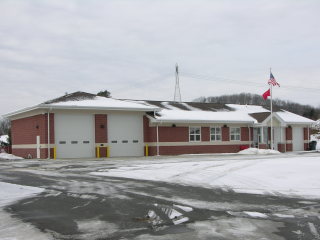
In 2000, the fire company also purchased a 100’ Sutphen aerial tower at a cost of about $850,000. That same year, the Snorkel was sold to a fire department near Rochester, New York.
In 2001, the township purchased a new Incident Command Chevy Suburban with a new odyssey package for the cost of $70,000 and the Relief Association purchased a new 2001 squad truck for the fire company for the cost of $45,000 and all three units were put in service that year.
In 2002, the fire company received an OSFC grant for $30,000 and the money was used to construct two 30’ by 30’ concrete pads in the training area. One pad was for vehicle extraction training and the other pad was piped with propane for car fire training.
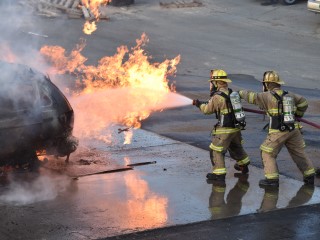 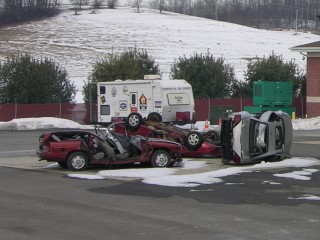
In 2003, after serving the township for more than thirty years, the old Mack pumper was finally retired. Today, the Mack pumper serves as a training apparatus at the Butler County Community College Public Safety training facility. In July 2003, a brand-new Precision/Spartan pumper was delivered and put into service and the 1989 FMC Pumper was moved into a reserve status.
In 2004, the township purchased a second Incident Command vehicle which was a 2004 Chevy Tahoe for the Assistant Chief of the fire company.
In 2005, the township budgeted for the construction of a training tower at the Public safety training grounds at a cost of $355,000. The project was completed late in 2005. It is a four-story training tower with a smoke maze room on the right side.
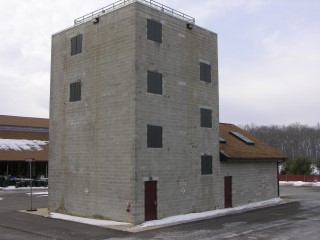
In 2006, the Relief Association purchased a second squad for the fire company and a third Incident Command vehicle for a cost of around $75,000. Both were put into service that year.
In 2007, a truck committee was formed to build the specifications for a new heavy rescue. That truck was purchased new in 2008 from KME and delivered in 2009.
In 2010, after many years of using their own vehicles for doing fire police duties, the Cranberry Township Volunteer Fire Company fire police took delivery of a Chevy Suburban to use as their first fire police vehicle.
In 2011, and after nearly two years of relentless efforts by fire company members, the fire company was very fortunate to be the recipient of a piece of steel from one of the twin towers. This piece of steel became the focal point of a memorial to honor the attack of our country on 9/11. That memorial was built in the front of our Park Fire station on Route 19 and was dedicated and open to the public on September 11, 2012.
In 2012, the township built the public safety training facility at the training ground area at a cost of $1.2 million. The building has one large class room that can be divided into two smaller classrooms. The building has two large bays for vehicles and two smaller bays to use for storage. Also in 2012, the fire police received a brand new 2012 Ford F-250 pickup truck from the Relief Association as their second fire police vehicle.
In 2013, the township purchased a new 2013 Chevy Tahoe Incident Command vehicle with LED lighting at a cost of $65,000 to replace the old 2004 Chevy Tahoe that was being used by Assistant Chief.
In early 2014 the fire company received another grant from the OFSC in the amount of $14,000 to build an outside field classroom at the Public Safety training facility on the training grounds.
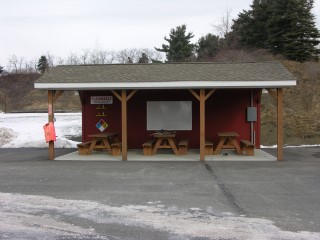
In 2015, the fire company was very busy projects. The fire company received another grant from the OFSC for outside lighting at the Public safety training facility to light up the training grounds. The township also purchased another 2015 Chevy Tahoe Incident Command vehicle for the fire Chief. The fire company also took delivery of its second aerial ladder truck which was a 2015 Pierce 75 foot straight stick at a cost of just under $1,000.000. The new ladder was housed at the Haine School station. Along with all that, the fire company received a new fire safety house for its fire prevention program. This new addition to the fire company came from the Cranberry Township Community Chest organization at a cost of about $40,000.
After a banner year in 2015, the fire company just kept moving forward and in 2016 received another OFSC grant for $13,930 dollars to upgrade all the I/T equipment in the public safety training facility.
In 2016, the Fire Company embarked on a very aggressive strategic planning effort and with the assistance of a citizen’s ad hoc committee and tremendous support from township leaders, a new strategic vision was established. The strategic plan set a framework for the fire company leaders to focus on and the officers of the fire company went right to work detailing out the action items. The foundation of the strategic planning work was to ensure the fire company would remain a viable volunteer organization for years to come.
2017 - Chief DFES
2017 marked a year that kicked off with the implementation of the strategic planning session that was completed in 2016 by VFIS. One of these strategic initiatives recognized the fact that the Chief's position was becoming increasingly demanding and there was a significant amount of turnover in the position. This turnover caused the organization to start down numerous strategic paths over the course of several years based on the changing Chief Officers. In 2017, the Township hired a Director of Public Safety that was renamed the Chief of Fire & Emergency Services. This Chief was to function as administrative/strategic oversight and direction as well as complete the implementation of the strategic planning objectives that were specified.
2018 - Training Coordinator, Fire & Risk Reduction, fleet reduction
During the strategic planning sessions, there were also several other personnel needs identified. In an attempt to further reduce the burdens of the heaviest workloads within the organization, the group felt that it was imperative to hire two other positions. Those positions would come to be known as the training coordinator and fire & risk reduction coordinator. The training coordinator would solely focus on the development of the membership and be the membership's gateway to education and training. The Fire & Risk Reduction Coordinator would focus on reducing risk within the township. This could mean everything from assisting with codes, compliance with ISO, Emergency Management Agency, staffing program, to fire alarm billing.
During the year, we also focused on the fact that we had a fleet of apparatus that was in need of being reduced and redesigned to meet the needs of our area. When apparatus focus on multiple different things, you are rarely good at one thing. This is where we decided to focus our engines on engine work, tower on truck work, and our rescue on rescue work. During the course of the year, a team of individuals worked tirelessly with multiple manufacturers to redesign and reduce the fleet. By the end of the year, the organization placed orders for 2 new engines and 1 new tower. While all of this was going on, we were also planning for our station expansion, which was another strategic initiative that was identified in the 2016 study.
2019 - Staffing Program, E21 & E21-2, Station Renovations, by-laws
The station expansion at Park and the renovations at Haine were completed in 2019. These renovations essentially modernized the firehouses to accommodate 24-hour staffing. It provided showers, kitchen, dayroom, offices, and bedrooms. This was accomplished in the existing space that Haine firehouse and an addition to the Park firehouse. After the completion of the renovations, we then had the ability to implement a staffing program at the firehouse. This staffing program is funded through the fire tax, and the firefighters are provided a stipend for being there for blocks of hours. This staffing program helped our response times and numbers to go from an average of 18 minutes with 1 or 2 people to an average of 8 minutes with 3-4 people.
During the year, we took possession of the twin engines that would be located at each firehouse. These engines were designed around moving water, and that was their focus. They provide a wide assortment of handlines in various lengths from the bumper to the cross lays to the rear lines.
As they continued to chip away at the strategic initiatives, they found that there was a significant need to redo the organizational by-laws. These bylaws would be focused on removing a lot of old ways of operating and move a lot of it to the PPGs (policies, procedures, and guidelines) and reference them as the guiding documents.
2020 - Chief DFES Change, Tower 21, COVID, PPG development
In the first few weeks of 2020, the organization experienced a change in the Chief of DFES position, and the township hired a new Chief into the role. The Chief of DFES would be restructured to be in charge of operations and a parallel to the Board of Directors within the organization. With this came a change that the township's contract with the CTVFC would not need to be renewed at set intervals; the Chief of DFES would monitor the organization for any issues or concerns with the contract details.
During the first few months of the new chief being hired, he had the challenge to help the organization manage COVID. The organization, with the assistance of the Board of Directors and the township, navigated its way through these uncharted waters with ease. Following the best-known direction that they could, they managed to control the illness from running rampant in the firehouse and also put up impressive staffing numbers 24 hours a day due to people working from home.
During this time period, the Department of Fire and Emergency Services were privileged to get some repurposed help from codes and the police administration. This freed up the group to begin to work on our comprehensive policy book that we know as the PPGs. The CTVFC Board of Directors developed and controlled all of the membership-focused documents while the DFES would develop the DFES administrative, operations, safety, training, risk reduction, and fire police policies.
2021 - Burn Building, Cadet academy, Officer Selection Process
Finding ourselves wanting to capitalize on our training amenities and space that we have, we began to design and construct a 3-story class A burn building at the public safety training center. This burn building's focus would be that we could perform real-life scenarios right here in our backyard without ever going out of service. It also allowed us to not have approximately 1-2 hours in prep, travel, and clean-up to burn with our firefighters as a group. This building was generously funded through our relief association and township capital fund for the groundwork.
During the year, we were fortunate enough to establish our first-ever township internship program. The internship would focus on preplanning of our high-risk occupancies, MSDS program, and the implementation of a Cadet Fire Academy. The interns hosted a weeklong 40-hour training for 14–17-year-old kids that were interested in the fire service. The students threw ladders, pulled hoselines,
learned CPR, and performed searches. In the end, an incredible 80% of them joined their local fire department!
After a few false starts due to missing pieces of PPG’s, the organization focused its efforts on the implementation of an officer selection process. This process was yet another focus of the 2016 strategic planning that was completed. The selection process would focus on officer qualifications, a letter of intent, a written test, a practical test, and an interview for the candidates. The goal was to ensure we put effective leaders into position and allowed them to do their jobs without fear of being voted out the following year.
2022 - 24-hour ERS, E21-3
At the end of the year the organization focused its efforts on training our firefighters in real world/real time incidents. This event would run for 24 hours and be known as the “training blitz” initially but renamed to the “24 hour ERS.” This ERS would allow the firefighters to experience the busiest of busiest days at the firehouse and is made to exhaust you. When you are exhausted what do you do, how do you perform, and what do you succeed or fail it. It pushes the limits of the individuals to ensure their personal readiness on the fireground. This training opportunity was such a success that the organization has hosted and expanded it annually.
Facing high repair bills of annually, the organization began to plan for the replacement of E21-3 that is at the Haine firehouse as our reserve/training engine. A team of individuals built a triplet to the twin engines with a few minor tweaks and changes that are lessons learned from the previous purchase. With the post-COVID build times, it will take 3 years for delivery of the apparatus. The new E21-3 will be the primary engine out of the Park firehouse once delivered. E21-2, which is our current workhorse of the firehouse, will become the reserve/training engine.
2023 - SAFER Grant, Training Coordinator Change, IC replacement, Squad replacement
After 3 failed attempts at obtaining a SAFER grant, the organization proudly accomplished securing funding from the federal government for a 4-year time period. This funding focused on several aspects of recruitment and retention like staffing, training, personal protective equipment, educational reimbursement, and hiring a new training coordinator. The sole goal of the grant is to make a smooth entrance into the firehouse as well as a smooth transition through training programs up to firefighter 1 and beyond.
Recognizing that we have taken great strides through policy to reduce the risk of cancer to our members, we focused our efforts on a vehicle style change for the Chief officers. We changed out our standard SUV for a pick-up truck that removed the carcinogens from the cabs of the vehicle. On top of that incident command vehicles, we also chose to replace the two aged squads at both firehouses. The new squads are both identical and are an F550 with a fully enclosed utility body on the rear. All of the new vehicles matched the current modern color scheme and were funded by the Relief Association.
By the end of 2023, we recorded a record number of calls for the organization - 1,021. This call volume is attributed to a lot of things like growth and activity but also an abnormally high call volume related to struck gas lines from the installation of fiber optic lines to every home in the township.
2024 - Rescue 21, 65th anniversary, stipend increase
We started the year off with the purchase of our final piece of apparatus that needs to be replaced for the foreseeable future. An order for a heavy-duty tandem axle walk-in rescue was placed in the first few weeks of 2024. This apparatus focuses on what we have done with the rest of the apparatus and allows it to solely focus on rescue work. The goal is for it to be able to get anyone in the township out of any situation. The organization will not take delivery of it until 2028 due to post-COVID delivery delays and cost increases.
In January at our annual awards banquet, the organization proudly celebrated our 65th anniversary of service to our community. It is an impressive feat for an organization to survive for 65 years and be in the position that it is in today. A lot of what we are capable of doing today is attributed to many of those people that came before us that made hard decisions on relationships, partnerships, and investments.
Recognizing that things cost more for our firefighters, the organization increased the amount being paid as the stipend by $5.00 at the beginning of the year. Firefighters now receive $30.00 per shift for them being at the firehouse and ready to respond.
| 
